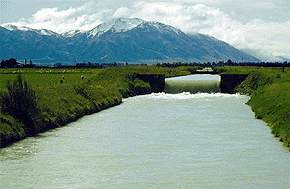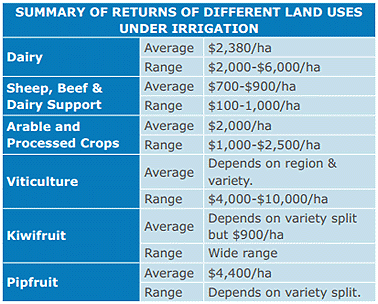
[This is the concluding part in a series of four. Part one focuses on dairy, part two on sheep, beef and dairy support, and the third part on horticulture, arable and processed crops.]
The benefits of irrigation have been known for a very long time, but despite this, New Zealand still only irrigates about 5 percent of its pastoral land.
Part of the issue is the diminishing quantity of available water for irrigation.
Around 41 percent of water used for irrigation is extracted relatively easily from groundwater sources stored naturally in aquifers. Access to this water is regulated by local government and was historically issued on a first-in first-served basis.
Over time the race to access water has meant that in some regions water has been fully allocated, or over-allocated. Furthermore, with water conservation becoming increasingly important, extraction from run of river is no longer a viable means for long-term water security.
With the realisation that water is a finite resource, there’s additional motivation for investment to capture water in order to make use of it at the right time, the right place, and in the right amount.
The development of more water storage and enhancements to existing irrigation schemes are key to primary sectors unlocking offshore opportunities.
The potential ability to export embodied water and better manage the volatility of Mother Nature means huge attention needs to be given to deriving cash value from storage.
The table below provides a summary of our findings on the potential earnings of different land uses under irrigation.
As we have highlighted, there are many factors a farmer/grower needs to weigh up when looking at the returns of different land uses under irrigation. There is no “one size fits all” solution.
For any farmer considering their own particular situation it pays to invest in good advice to work out the viable options.
Many new schemes have shown a high turnover in business ownership (and usually, but not always, associated land ownership) of around 70 percent within five years of a scheme’s commissioning.
Associated with this change has usually been the introduction of some new expertise and additional equity, so that not all the marginal capital required to install irrigation and change land use or farm policy is debt funded.

-------------------------------------------------------------------------------------------------------------------------------------------
Farms For Sale: the most up-to-date and comprehensive listing of working farms in New Zealand, here »
-------------------------------------------------------------------------------------------------------------------------------------------
Most of our analysis has shown top farm management performance, moderate-to-average existing debt levels, and reasonable prices are often required to make new irrigation work for an existing land owner.
Additionally, to make money from irrigation, a farm needs to be set up to maximise production and revenue every year, rather than just aiming to mitigate the risks of drought.
Productivity of new farms taking up irrigation will often be at the top end of the range because of:
• Younger farmers taking over management through family succession, or change of ownership;
• Top performers buying more land and expanding;
• High debt levels sharpening performance;
• Leveraging new technology eg. new centre pivots compared to older technology such as gun irrigators, or even flood irrigation, helps mitigate poor management;
• Reliability and increased confidence allows the system to be run to its maximum and avoids conservatism being applied in the farming operation;
• In many cases partial irrigation lifts the productivity of the non-irrigated part of the farm and is likely to provide the best return for those short on capital to invest.
Even some of the high-productivity assumptions used in certain models could be conservative in 20 years’ time for three reasons:
• New innovation;
• Macro-economic drivers and improving real terms of trade for the primary sectors;
• New irrigation technology.
One needs only to look at the amount of innovation and changes in farming practice that have occurred in the last 20 years to get a sense of what is possible.
The three factors above should boost real returns over time, which improves the rate of return on sunk capital.
Depending on the property market the additional capital expenditure to convert to irrigation is usually also capitalised into the value of the enterprise.
Historically there have been steep initial capital gain opportunities associated with irrigation investment, and the associated change of land use.
What seems more likely at this point in time though is a more gradual accrual of value at a slightly faster rate than non-irrigated land.
In many cases where new irrigation is planned, land values are already quite high, farm-gate returns remain volatile, and new irrigation developments are generally higher cost than has historically been the case.
Another area we have not covered is the execution side of implementing new irrigation and a change of land use or farm policy. The first few years of a new investment and change of land use is when vulnerability is at its highest.
Developing a business plan, project plan, and budget, as well as completing the changeover on time, to specifi cation and within budget, are critical components for any new investment.
Not getting this right often leads to a business being tripped up and not succeeding.
Get the execution right, and what our analysis has shown is that – in most cases – investment in irrigation can be made to work in today’s business environment despite the many challenges and the higher cost of accessing water.
-------------------------------------------------------------------------------------------
This article was first published in the ANZ Rural Focus. It is reprinted here with permission. The full Report is here.
We welcome your comments below. If you are not already registered, please register to comment
Remember we welcome robust, respectful and insightful debate. We don't welcome abusive or defamatory comments and will de-register those repeatedly making such comments. Our current comment policy is here.